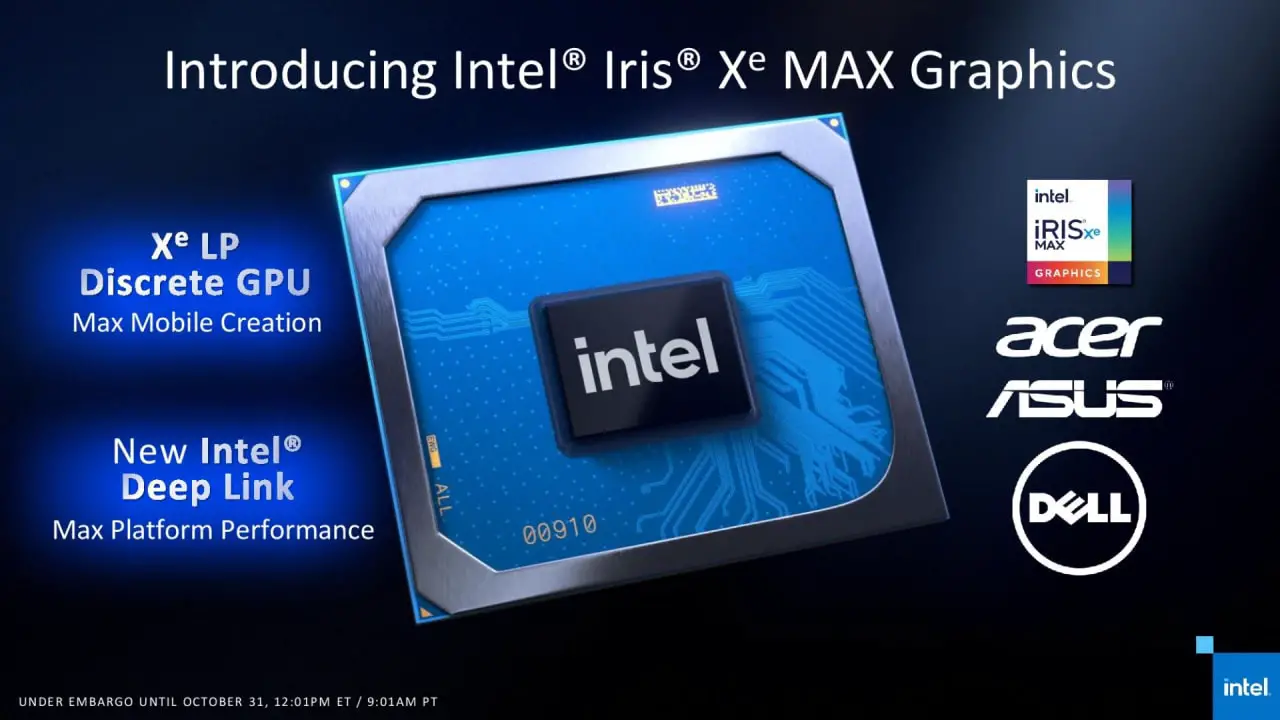Despite the fact that Intel’s first dedicated graphics card on the Xe architecture for laptops has already been revealed, the company officially lifts the cover. Intel Iris Max is the graphics card that previously went by the code name DG1 with the architecture Xe-LP, which is used in the simpler collection of graphics circuits. With the Iris Xe Max, Intel does not aim to far surpass competing graphics circuits in pure computing capacity, but instead make better use of available resources with the Deep Link technology.
Iris Max is a dedicated graphics circuit (dGPU) that complements the processor’s integrated graphics circuit (iGPU). The presentation images Intel publishes show that the computing capacity of the Iris Xe Max is relatively close to its integrated counterpart in the Tiger Lake processor family. The great success formula for Intel’s solution lies in Deep Link, a software framework that can utilize all computing units in the system.
A system that applies Deep Link can let the integrated graphics part collaborate with both the processor and the dedicated graphics circuit. In a system with, for example, a processor from Intel and a graphics card from Nvidia, tasks must be shared between the devices, and a task that is processed on the graphics card cannot be handled by the processor. With Deep Link, the limited resources of a laptop will be better utilized, and the technology can be combined with Intel’s One API framework.
In terms of specifications, the Iris Max adheres to the same configuration as its integrated counter-pole, which means 96 computing units (EU) and support for variable image quality (VRS) and AV1 video decoding. The big difference from integrated Xe graphics lies in the higher power budget (TDP), which enables an increase in clock frequency from 1.35 GHz to 1.65 GHz. The Iris Xe Max is also equipped with 4 GB of graphics memory with a bandwidth of 68 GB / s.
In addition to a technical explanation, Intel also delivers performance results for the Iris Xe Max, where the company compares its own solution with the previously mentioned graphics circuit MX350 from Nvidia. Intel does best in the game titles GRID 2019 and Metro Exodus, where 46 and 43 FPS respectively surpass the MX350 with 37 and 29 FPS respectively. In other titles, the two graphics chips achieve comparable results, with little advantage for Nvidia in Borderlands 3 and Gears Tactics.
The area where Iris Max and Deep Link also surpass some of the market’s fastest graphics cards is in calculations related to machine learning (ML). As Intel’s ML instructions DL Boost are available in both Xe-LP in integrated and dedicated form as well as in the eleventh generation Core processors, it will be possible via Deep Link to utilize DL capacity for all three computing units.
The advantages can be seen in the results where the combined resources are 78 percent faster than a system with the graphics card Nvidia Geforce RTX 2080 for video coding. The performance gain means that an Iris Xe Max system via Deep Link can recode an AVC clip in 4K and 60 FPS to HEVC in 1080p and 60 FPS up to 78 percent faster than a Geforce RTX 2080-equipped system can.
Like AMD’s Smartshift solution, Intel’s processor and graphics circuitry combinations of both integrated and dedicated types can apply dynamic power distribution. It will allow the unit that needs a larger part of the TDP budget to be allocated this. The power supply can then, for example, increase for the processor when it is under heavy load and then switch to Iris Xe Max when the need is greater. The circuits themselves are made energy efficient through Intel’s refined transistor technology 10nm Superfine.
Intel announces that the Iris Xe Max with Deep Link is implemented in the computers Acer Swift 3x, Asus Vivobook Flip TP470 and Dell’s hybrid computer Inspiron 15 7000. In terms of software that can use Deep Link, Handbrake is listed for video coding and video transmissions via OBS. Support for modeling in 3D via Blender will be added in the future.















